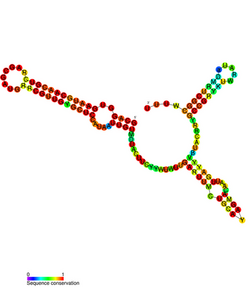Biology:FnrS RNA
| FnrS | |
|---|---|
 Conserved secondary structure of FnrS RNA. The colour of nucleotides indicate their conservation within the family. | |
| Identifiers | |
| Symbol | FnrS |
| Rfam | RF01796 |
| Other data | |
| RNA type | Gene |
| Domain(s) | Enterobacteriaceae |
| PDB structures | PDBe |
FnrS RNA is a family of Hfq-binding small RNA whose expression is upregulated in response to anaerobic conditions. It is named FnrS because its expression is strongly dependent on fumarate and nitrate reductase regulator (FNR), a direct oxygen availability sensor.[1][2]
A conserved intergenic region between genes ydaN and dbpA was predicted to encode an sRNA, adjacent to where another non-coding RNA (C0343) has been identified.[3] However, northern blot analysis of this 477bp sequence yielded no results.[4] A subsequent tiling array analysis sequencing Hfq-binding sRNA found that the Watson strand did indeed encode an sRNA.[1]
Gene regulation
FnrS has been shown to downregulate 32 different mRNAs in Enterobacteria, in 15 of these cases it does so by base-pairing with the mRNA transcript.[1] The majority of genes downregulated by FnrS are required for aerobic metabolism or the oxidative stress response.[2] Some of the genes downregulated by FnrS are:[1]
- adhP - an alcohol dehydrogenase involved in metabolism
- cydD - zinc sensitive ATP-binding component of cytochrome-related transport[5]
- mqo - membrane associated malate:quinone oxidoreductase which operates in the citric acid cycle[6]
- sodB/A - a superoxide dismutase which aids with oxygen stress resistance[7]
- ygiW - a hypothetical outer membrane protein[8]
A study incorporating comparative target prediction and subsequent experimental verification of selected predictions, suggests that FnrS might be a more global regulator in Escherichia coli. It is predicted to control several transcription factors. These include the verified targets marA and IscR.[9] MarA activates genes involved in the resistance to superoxide,[10] which might not be necessary at the anaerobic conditions where FnrS is expressed. IscR regulates genes for iron-sulfur-cluster containing or biogenesis proteins.[11] FnrS might be involved in the observed O2 dependent expression of the IscR regulon.[11] Further targets of FnrS are nagZ and sdhA.[9]
There is also evidence to suggest that the expression of FnrS is regulated by the RcsCDB signalling system in Salmonella enterica.[12]
References
- ↑ 1.0 1.1 1.2 1.3 "Reprogramming of anaerobic metabolism by the FnrS small RNA". Mol. Microbiol. 75 (5): 1215–1231. March 2010. doi:10.1111/j.1365-2958.2010.07044.x. PMID 20070527.
- ↑ 2.0 2.1 "Translational regulation of gene expression by an anaerobically induced small non-coding RNA in Escherichia coli". J. Biol. Chem. 285 (14): 10690–10702. April 2010. doi:10.1074/jbc.M109.089755. PMID 20075074. PMC 2856277. http://www.jbc.org/cgi/pmidlookup?view=long&pmid=20075074. Retrieved 2010-08-05.
- ↑ "Transcriptome analysis of Escherichia coli using high-density oligonucleotide probe arrays". Nucleic Acids Res. 30 (17): 3732–3738. September 2002. doi:10.1093/nar/gkf505. PMID 12202758.
- ↑ "A computational approach to identify genes for functional RNAs in genomic sequences". Nucleic Acids Res. 29 (19): 3928–3938. October 2001. doi:10.1093/nar/29.19.3928. PMID 11574674.
- ↑ "The cydD gene product, component of a heterodimeric ABC transporter, is required for assembly of periplasmic cytochrome c and of cytochrome bd in Escherichia coli". FEMS Microbiol. Lett. 117 (2): 217–223. April 1994. doi:10.1111/j.1574-6968.1994.tb06768.x. PMID 8181727.
- ↑ "Functions of the membrane-associated and cytoplasmic malate dehydrogenases in the citric acid cycle of Escherichia coli". J. Bacteriol. 182 (24): 6892–6899. December 2000. doi:10.1128/jb.182.24.6892-6899.2000. PMID 11092847.
- ↑ EntrezGene 944953
- ↑ EntrezGene 8872708
- ↑ 9.0 9.1 "Comparative genomics boosts target prediction for bacterial small RNAs.". Proc Natl Acad Sci U S A 110 (37): E3487–E3496. 2013. doi:10.1073/pnas.1303248110. PMID 23980183. Bibcode: 2013PNAS..110E3487W.
- ↑ "Promoter Discrimination at Class I MarA Regulon Promoters Mediated by Glutamic Acid 89 of the MarA Transcriptional Activator of Escherichia coli.". J Bacteriol 193 (2): 506–515. 2011. doi:10.1128/JB.00360-10. PMID 21097628.
- ↑ 11.0 11.1 "IscR-dependent gene expression links iron-sulphur cluster assembly to the control of O2-regulated genes in Escherichia coli.". Mol Microbiol 60 (4): 1058–1075. 2006. doi:10.1111/j.1365-2958.2006.05160.x. PMID 16677314.
- ↑ "Inverse regulation in the metabolic genes pckA and metE revealed by proteomic analysis of the Salmonella RcsCDB regulon.". J Proteome Res 10 (8): 3386–3398. 2011. doi:10.1021/pr101294v. PMID 21657791.
Further reading
- "Experimental discovery of small RNAs in Staphylococcus aureus reveals a riboregulator of central metabolism". Nucleic Acids Res 38 (19): 6620–6636. May 2010. doi:10.1093/nar/gkq462. PMID 20511587.
- "Identification of non-coding RNAs in environmental vibrios". Microbiology 156 (Pt 8): 2452–2458. August 2010. doi:10.1099/mic.0.039149-0. PMID 20447992.
External links
 |

